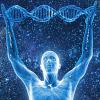High protein intake is associated with low plasma NAD+ levels in a healthy human cohort
PLoS One. 2018 Aug 16;13(8):e0201968. doi: 10.1371/journal.pone.0201968. eCollection 2018.
Neda Seyedsadjadi, Jade Berg, Ayse A. Bilgin, Nady Braidy, Chris Salonikas, Ross Grant
...we used a cross-sectional study design of 100 apparently healthy middle-aged males (n = 48) and females, in which we assessed average dietary intakes of multiple components using a validated questionnaire. ... [P]lasma levels of NAD+ and Total NAD(H) were lower with increasing protein intake (F (2, 92) = 4.61, P = 0.012; F (2, 92) = 4.55, P = 0.013, respectively). The associated decrease in NAD+ and NAD(H) levels was even stronger with increasing plasma levels of the protein breakdown product urea (F (2, 93) = 25.11, P≤0.001; F (2, 93) = 21.10, P≤0.001).
[See the graph here. The mean protein intake was 79.29 ± 30.34 g/day; it's unclear from Table 1, but either the tertiles of protein intake were 70, 75, and 94 g protein/d, or the protein intake levels in the three tertiles of urea were thus -MR]
These associations were all independent of age, gender and energy intake. ... but not after Bonferroni adjustment (P>0.002). ... However, no significant association was observed between protein intake or plasma urea, and plasma levels of NAD+ metabolites [[NADP+, cyclic ADP ribose (cADPR), nicotinamide (NAM), N-methylnicotinamide (MeNAM)]] ... We also observed that plasma levels of the inflammatory cytokine IL-6, and both Kyn, and Trp, but not the Kyn/Trp ratio were higher with increasing plasma urea levels (F (2, 94) = 3.30, P = 0.041; F (2, 95) = 7.41, P≤0.001; F (2, 96) = 4.23, P = 0.017, respectively). These associations were dependent on eGFR and energy intake, except for the urea and Trp association that was independent of all. In conclusion, we report for the first time, a novel association between protein intake, its metabolism, and plasma NAD+ levels with a possible link to inflammation.
PMID: 30114226 DOI: 10.1371/journal.pone.0201968
The fact that the association didn't survive Bonferroni adjustment may very well mean this is spurious. Repeating this study with this as the primary hypothesis, and in a larger cohort with a wider range of protein intakes, would resolve the issue. I'd also like to see it broken down by animal vs. plant protein.
































 This topic is locked
This topic is locked













